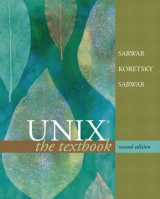
UNIX
Pearson (Verlag)
978-0-201-61260-8 (ISBN)
- Titel erscheint in neuer Auflage
- Artikel merken
UNIX: The Textbook assumes that the reader has no background in UNIX. This book tours the UNIX applications interface, guiding the student through operating system utilities including process, file, storage, and I/O management. Using this approach, students quickly learn to navigate the applications interface while broadening their understanding of operating system principles. This unique organization combined with additional coverage of UNIX software development tools and a quick-reference command appendix benefits the beginning student as well as the skilled UNIX user in demand of a solid reference text.
(Each chapter begins with an "Introduction," and concludes with a "Summary" and "Problems.")
1. Overview of Operating Systems.
What is an Operating System?
Operating System Services.
Character Versus Graphical User Interface.
Types of Operating Systems.
The UNIX Family.
2.Brief History of the UNIX Operating System.
Historical Development of the UNIX Operating System.
Beginnings
Research Operating System
AT&T System V
Berkely Software Distributions.
The History of Shells
Current and Future Developments - LINUX
Variations in UNIX Systems.
3. Getting Started.
Computer System Hardware.
Main/Primary Storage
Central Processing Unit (CPU).
Disk
Bus
I/O Devices
UNIX Software Architecture.
Device Driver Layer.
The UNIX Kernel.
The System Call Interface.
Language Libraries.
UNIX Shell.
Applications
Logging On and Logging Off.
Correcting Mistakes.
Some Important System Setups.
Some Useful Commands for the Beginner.
Changing Your Password.
Getting Help
Finding Out Who You Are and What the Name of Your UNIX System is.
4. UNIX Shell.
Various UNIX shells.
Shell Programs.
Which Shell Suits your Needs?
Ways to Change Your Shell
Shell Start-up Files and Environment Variables.
Some Other Useful General-Purpose Commands
Creating and Displaying Directories.
Displaying Files
Printing Files
Displaying a Calendar
One-Way Real-Time Messaging.
Notification of and Permission for Electronic Communication.
Creating Pseudonyms for Commands
Displaying System Up Time
Shell Metacharacters (lpr).
5. Editing Text Files.
How to Do Short and Simple Edits by Using the pico Editor.
Creating the Text of an e-mail Message with the pico Text Editor.
How to Start, Save a File, and Exit.
General Keystroke Commands and Cursor Management.
Cutting/Pasting and Searching.
Obtaining More Control by Using the vi Editor.
Shell Script File.
How to Start, Save a File and Exit.
The Format of a vi Command and the Modes of Operation.
Cursor Movement and Editing Commands.
Yank and Put (Copy and Paste) and Substitute (Search and Replace).
Setting the vi Environment.
Executing Shell Commands from Within vi.
Getting Maximum Control by Using the emacs Editor.
DOS Aliases
How to Start, Save a File, and Exit.
Cursor Movement and Editing Commands.
Keyboard Macros
Cut or Copy and paste and Search and Replace.
Optional - How to Do Graphical Editing Using emacs and theX Window System.
Editing Data Files.
How to Start, Save a File, and Exit.
X Window emacs Menus.
6. Electronic Mail.
How to Use the UNIX mail command Effectively.
Sending and Reading e-mail with the UNIX mail Command.
Sending e-mail with mail.
Reading e-mail with mail.
Saving Messages in Folders.
Replying to and Forwarding Messages - and Including Attachment.
mail Aliases.
Elm - A Full Screen Display Email System.
Sending a Message in elm.
Sending e-mail with elm.
Reading e-mail in elm.
Forwarding and Replying to e-mail Message in elm.
Saving Message in Folders.
elm Aliases.
Pine - Another Full-Screen Display e-mail System.
Sending an e-mail Message by using pine with an Attachment Created in vi.
Sending e-mail with pine.
Reading e-mail with pine.
Disposing of e-mail in Folders in pine.
Using the pine Address Book.
A Summary pine Commands.
7. Files and File System Structure.
The UNIX File Concept.
Types of Files.
Simple/Ordinary File.
Directory.
Link File.
Special File (Device)
Named Pipe (FIFO)
File System Structure.
File System Organization.
Home and Present Working Directories.
Pathnames: Absolute and Relative.
Some Standard Directories and Files.
Navigating the File Structure.
Determining the Absolute Pathname for Your Home Directory.
Browsing the File System.
Creating Files.
Creating and Removing Directories.
Determining File Attributes.
Determining the Type of a File's Contents.
File Representation and Storage in UNIX.
Standard Files and Files Descriptions.
End of File (eof) Marker.
8. File Security.
Password-Based Protection.
Encryption-Based Protection.
Protection Based on Access Permissions.
Types of Uses.
Types of File Operations/Access Permissions.
Determining and Changing File Access Privileges.
Determining File Access Privileges.
Changing File Access Privileges.
Default File Access Privileges.
Special Access Bits.
The Set-User-ID (SUID) Bit.
The Set-Group-ID (SGID).
The Sticky Bit.
9. Basic File Processing.
Viewing Contents of Text Files.
Viewing Complete Files.
Viewing Files One Page at a Time.
Viewing the Head or Tail of a File.
Copying, Moving, and Removing Files.
Copying Files.
Moving Files.
Removing/Deleting Files.
Determining File Size.
Appending to Files.
Combining Files.
Comparing Files.
Removing Repeated Lines.
Printing Files and Controlling Print Jobs.
UNIX Mechanism for Printing Files.
Printing Files.
Finding the Status of Your Print Request.
Canceling Your Print Jobs.
10. Advanced File Processing.
Regular Expressions.
Compressing Files.
Sorting Files.
Searching for Commands and Files.
Searching Files.
Cutting and Pasting.
Encoding and Decoding.
File Encryption and Decryption.
11. File Sharing.
Duplicate Shared Files.
Common Login for Members of a Team.
Setting Appropriate Access Permissions on Shared Files.
Common Group for Members of a Team.
File Sharing Via Links.
Hard Links.
Drawbacks of Hard Links.
Soft/Symbolic Links.
12. Redirection and Piping.
Standard Files.
Input Redirection.
Output Redirection.
Combining Input and Output Redirection.
I/O Redirection with File Descriptors.
Redirecting Standard Error (2>>).
Redirecting stdout and stderr in One Command.
Redirecting stdin, stdout, and stderr in One Command.
Redirecting Without Overwriting File Contents. (Appending)
UNIX pipes (|).
Redirection and Piping Combined.
Error Redirection in the C Shell.
Recap of I/O and Error Redirection.
13. Processes.
Running Multiple Processes Simultaneously.
UNIX Process States.
Execution of Shell Commands.
Process Attributes.
Process and Job Control.
Foreground and Background Processes and Related Commands.
UNIX Daemons
Sequential and Parallel Execution of Commands.
Abnormal Termination of Commands and Processes.
Process Hierarchy in UNIX.
14. Networking and Internetworking.
Computer Networks and Internetworks.
The Reasons for Computer Networks and Internetworks.
Network Models.
The TCP/IP Protocol Suite.
TCP and UDP.
Routing of Application Data - The Internet Protocol (IP).
Ipv4 Addresses in Dotted Decimal Notation.
Symbolic Names.
Translating Names to IP Addresses - The Domain Name System.
Internet Services And Protocols.
The Client-Server Model.
Application Software.
Displaying the Host Name.
Displaying List of Users Using Host on a Network.
Testing a Network Connection.
Displaying Information about Users.
Remote Login.
Remote Command Execution.
File Transfer.
Remote Copy.
Interactive Chat.
Tracing the Route from One Site to Another Site.
15. Introduction To Bourne Shell Programming.
Running a Bourne Shell Script.
Shell Variables and Related Commands.
Reading and Writing Shell Variables.
Command Substitution.
Exporting Environment.
Resetting Variables.
Creating Read-Only User-Defined Variables.
Reading from Standard Input.
Passing Arguments To Shell Scripts.
Comments And Program Headers.
Program Control Flow Commands.
The if-then-elif-else-fi Statement.
The for Statement.
The while Statement.
The until Statement.
The break and continue Commands.
The case Statement.
16. Advanced Bourne Shell Programming.
Numeric Data Processing.
The Here Document.
Interrupt (Signal) Processing.
The exec Command and File I/O.
Execution of a Command Without Creating a New Process.
File I/O via the exec Command.
Functions in the Bourne Shell.
The Reasons for Functions.
Function Definition.
Function Invocation/Call.
Examples of Functions.
Debugging Shell Programs.
17. Introductory C Shell Programming.
Running a C Shell Script.
Shell Variables And Related Commands.
Reading and Writing Shell Vaiables.
Command Substitution.
Exporting Environment.
Resetting Variables.
Passing Arguments to Shell Scripts.
Comments And Program Headers.
Program Control Flow Commands.
The if-the-else-endif Statement.
The foreach Statement
The while Statement.
The break, continue, and goto Commands.
The switch Statement.
18. Advanced C Shell Programming.
Numeric Data Processing
Array Processing.
The Here Document.
Interrupt (Signal) Processing.
Debugging Shell Programs.
19. File System Backup.
Archiving and Restoring Files Via tar.
Archiving Files.
Restoring Archived Files.
Copying Directory Hierarchies.
Software Distributions In the tar Format.
20. UNIX Tools for Software Development.
Computer Programming Languages.
The Compilation Process.
The Software Engineering Life-Cycle.
The Program Generation Tools.
Generating C Source Files.
Indenting C Source Code.
Compiling C Program.
Handling Module-Based C Software.
Building Object Files into a Library.
Working with Libraries.
Version Control.
The Static Analysis Tools.
Verifying Code for Portability.
Source Code Metrics.
Dynamic Analysis Tools.
Tracing Program Execution.
Source Code Debugging.
Run-Time Performance.
21. X Window System - The UNIX Graphical User Interface.
User-Computer Interactivity and the X Window System.
The Key Components of interactivity - Events and Request.
The Role of a Window Manager in the User Interface and fvwm.
Functions and Appearance of the Window Manager Interface.
The Appearance and Operation of fvwm.
Customizing the X Window System and fvwm.
Command Line Changes to an X Window System Application.
Preference Changes in .Xdefaults and .xinitrc Initialization Files.
Typical Changes in .fvwmrc to Customize the fvwm Window Manager.
Appendix: Command Summary.
Glossary.
Index.
| Erscheint lt. Verlag | 4.9.2000 |
|---|---|
| Sprache | englisch |
| Maße | 158 x 232 mm |
| Gewicht | 998 g |
| Themenwelt | Informatik ► Betriebssysteme / Server ► Unix / Linux |
| ISBN-10 | 0-201-61260-7 / 0201612607 |
| ISBN-13 | 978-0-201-61260-8 / 9780201612608 |
| Zustand | Neuware |
| Haben Sie eine Frage zum Produkt? |
aus dem Bereich



